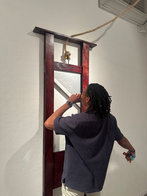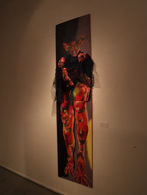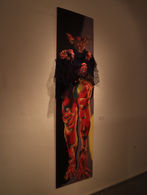Dickstruction.
Dickstruction emerged as a curatorial project grounded in the belief that exhibitions were not neutral containers of art but active, discursive spaces where meaning was produced, contested, and reframed. This exhibition intentionally engaged with critical curatorial theory that viewed the act of curation as a political and generative practice—one that had the capacity to challenge dominant visual and social narratives rather than merely reflect them.
Romina Villarreal and I co-curated this project, collaboratively inviting a diverse group of artists—including UNLV graduate students, faculty, and alumni from the Department of Art—to contribute work to the exhibition. Together, we shaped the show around the phallus as a persistent cultural symbol of power, stability, and control—a signifier whose authority had been inscribed across art history, media, and ideology. By foregrounding works that enacted both the literal and metaphorical destruction of this form, Dickstruction aligned itself with curatorial strategies that sought to expose, deconstruct, and destabilize the hegemonic systems embedded within visual culture. The project drew upon feminist and queer theoretical frameworks that positioned rage, disruption, and refusal as necessary tactics in the production of counter-narratives and subversive meaning.
Our curatorial approach emphasized process over containment, embracing the possibility of tension, discomfort, and institutional friction as generative forces rather than obstacles. When the exhibition’s promotional materials were quietly restricted by the university's administrative leadership—escalating to upper leadership in what we called the 'Three Angry Men' phenomenon—the curatorial space extended beyond the gallery walls and into the very structures that governed visibility and discourse. This event became a live example of curatorial theory in action: the exhibition did not simply stage a critique of power; it provoked and revealed it.
Rather than seeking consensus or comfort, Dickstruction intentionally unsettled the assumed stability of masculine-coded forms and the systems that upheld them. The works within the exhibition offered not resolution but rupture—insisting that the process of unmaking was as valuable, if not more so, than the assertion of new meaning. In this way, the project resonated with curatorial models that rejected neutrality and instead embraced the exhibition as a contested, provisional, and openly political space.
This experience reinforced my understanding of curation as a practice of framing conflict, enabling rupture, and amplifying dissent. Dickstruction demonstrated that exhibitions could serve as sites where dominant visual orders were not simply displayed or interpreted, but actively disassembled—where meaning was made through acts of interruption, inversion, and radical possibility.
























